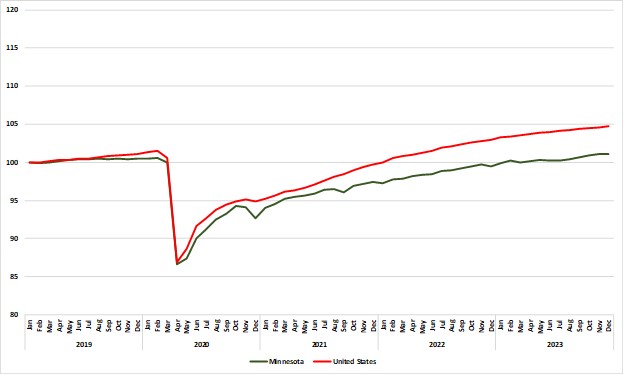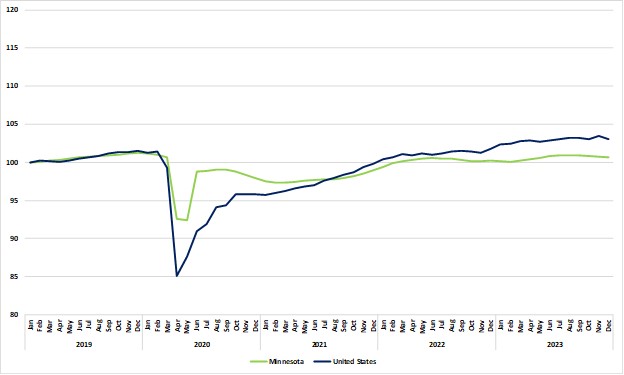Data show that employment in Minnesota fell for the third straight month in December
To know what is going on in Minnesota it is sometimes as useful to look at what our state’s media doesn’t say as at what it does say.
Number of jobs
Back in October, WCCO reported “Minnesota continues to outpace nation in job growth, DEED says“; in November, KSTP reported “Minnesota’s job growth last month outpaced the national rate…“; and in December, the Star Tribune reported “Minnesota job growth outpaces U.S.“
And yet, when December’s job numbers came out, there was no mention of Minnesota outpacing the nation. The best the Babbitts in the media could find to say was that the state had posted a sixth straight month of job growth.
This was true. Bureau of Labor Statistics‘ data show that the number of jobs in our state rose in every month from July to December 2023, by 800 in December, for an increase of 26,100 overall, or 0.9%. But the fact that Minnesota’s media stopped reporting our state’s job growth relative to that of the United States as a whole tells you that we are no longer outpacing it.
Indeed, as I noted back in October, Minnesota’s recent record of job growth compares poorly with that of the United States. As Figure 1 shows, while our job growth tracked that of the United States pretty closely to mid-2019, since then it has failed to keep pace. Indeed, if we look at the growth in jobs since the trough of the COVID-19 recession in April 2020, we see an increase of 16.7% in Minnesota compared to 20.5% for the United States as a whole.
Figure 1: Nonfarm job growth, Minnesota and the United States, January 2019 = 100

Source: Bureau of Labor Statistics
Number of people employed
But that’s not all. I’ve made the point previously that, while the number of jobs is one thing — it comes from the BLS’ Establishment survey as part of its Current Employment Statistics (CES) survey — the number of people actually employed is another — this comes from the Household survey which is conducted by the U.S. Census Bureau as part of its Current Population Survey (CPS). What do we see when we look at those numbers?
As Figure 2 shows, the total number of people employed in Minnesota fell in December by 1,797 and there are now 7,718 fewer people employed in Minnesota than there were back in September. This decline in employment — 0.3% — is fractionally above the decline in the United States over the same period, 0.2%.
Figure 2: Employment growth, Minnesota and the United States, January 2019 = 100

Source: Bureau of Labor Statistics
And again, we should also note that, over a longer time span, employment growth in Minnesota has lagged the national rate. Indeed, while the total number of people employed in the United States hit its peak in November, the peak in Minnesota was back in December 2019: total employment is still 16,701 below that.
Putting it all together
As I concluded in October:
Even with this relatively sluggish employment growth, Minnesota’s unemployment rate remains relatively low. That is because the growth rate of our total labor force has been similarly sluggish, in part because we hemorrhage residents to other states.
But how do we square increasing numbers of jobs with decreasing numbers of people employed..? Some of it, no doubt, is down to the fact that these are different surveys complied by different bodies measuring different things with different methods. But unless these surveys are useless, some of it, too, reflects more people holding multiple jobs. That is understandable in an economy where Americans are struggling to make ends meet, but it is not a cause for media celebration.